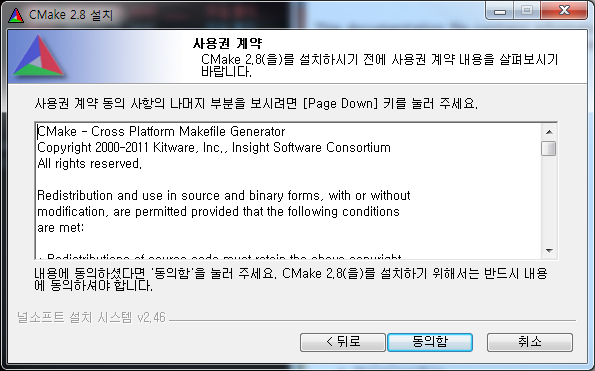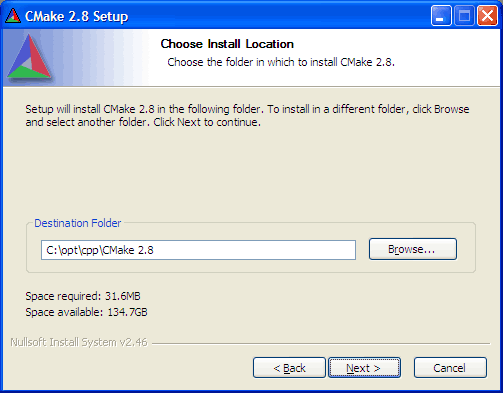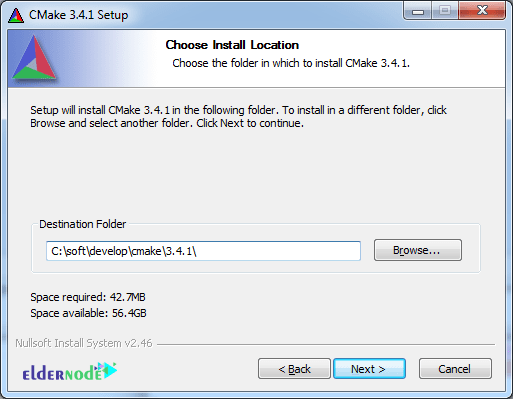
- #Installing cmake windows install#
- #Installing cmake windows generator#
- #Installing cmake windows manual#
- #Installing cmake windows code#
- #Installing cmake windows download#
Notice that the abstract description of our project above can be shared by developers on Windows, Linux. Then run your compiler, and finally the program. On Windows, run the CMake GUI, fill in the path to the example, click "configure", say what compiler you use, click "configure" again if needed, then click "ok". " in that directory, and then "make", and then "./example". Printf("CMake the world a better place!\n") In the same directory, create a file called "main.cpp". Inside that directory, create a file called "CMakeLists.txt". It can be useful to delete this if you want to start over completely.Ĭreate a new directory, something like $HOME/cmake/example or C:\cmake\example. The generated file "CMakeCache.txt" contains all settings stored by CMake. You can pass it values on the command line: "cmake" doesn't ask questions, and just uses defaults. "ccmake" is very much like the Windows GUI, and you may need to iterate "configure" a few times before the option to "generate" appears.
#Installing cmake windows code#
If you are running CMake while in a directory different to where your code is, replace "." with the path to your code. On UNIX CMake can be used conveniently in two ways: If you want to start over from the beginning with CMake, it is important to press the "delete cache" button to make it forget everything you've told it. Project files of the type you specified should exist in the build path you gave. When the "OK" button becomes clickable, then CMake has enough information to set up your project. Depending on the project, configuration may involve several steps - you may have to answer new questions and click "configure" again. Click that, then fill in the path to your code, and the path you want CMake to build in (that can be the same if you want). After installing, you should have an icon for CMake in your START menu. On Windows, the easiest way to use CMake is via its GUI. For example, if the cmake binary is installed in /opt/cmake/bin/cmake and you wish to execute it as /usr/local/bin/cmake, then make a script at /usr/local/bin/cmake with the contents: We suggest you use a short script rather than a symbolic link if you need to do something like this.
#Installing cmake windows install#
#Installing cmake windows download#
#Installing cmake windows manual#
See the manual for more: philosophical background, whether and how you can use Ninja for your project, platform support, and details about the language semantics. CMake lets us describe our programs and libraries in a cross-platform way. Ninja is used to build Google Chrome, parts of Android, LLVM, and can be used in many other projects due to CMakes Ninja backend.
#Installing cmake windows generator#
To achieve this without complete chaos, we ask you to install "CMake". CMake is a build system generator that can create, e.g., Makefiles for UNIX and Mac or Visual Studio project files for Windows. It is strange that this package does not add cmake to the path.We'd like you all to use the development environment you are used to, and not force you to switch to something else - no Linux/g++/emacs vs Windows/DevStudio vs Mac/. "The default behavior should add cmake to the PATH. "But maybe it's not clear why it is not the default. But the default with no flags should be a usable setup out of the box." If I didn't want to add it to path, I'd look up flags. "The entire point of a package manager is being just an "install x" away from being able to type "x args" in the command line, with sane defaults. I would expect to be able to execute cmake after installing cmake.

However, what currently happens is you install a dozen packages with chocolatey, and they all work correctly EXCEPT cmake! So, cmake requires some special configuration which is inconvenient and takes time to research.

It's similar to apt or yum on Linux systems.

Why is the change relevant? Well, chocolatey is a popular package manager, and when you install numerous packages with chocolatey you'd hope and expect they will all be functional after an installation. In specialized cases where the administrator prefers one of the other options, they may certainly pick those. That ought to be the second one: "Add CMake to the system PATH for all users". The default should be the most common and recommended choice.

For the Windows installer cmake-3.19.0-win64-圆4.msi, these choices are presented:


 0 kommentar(er)
0 kommentar(er)
